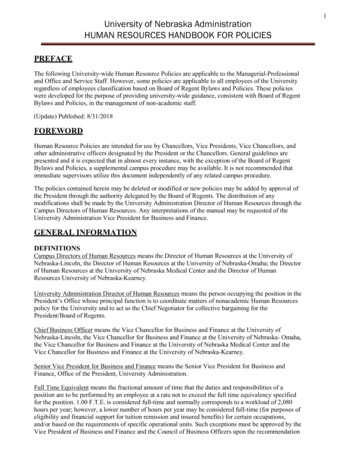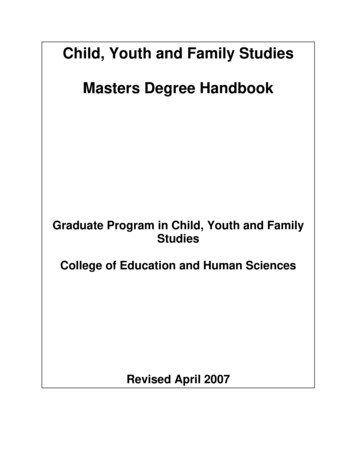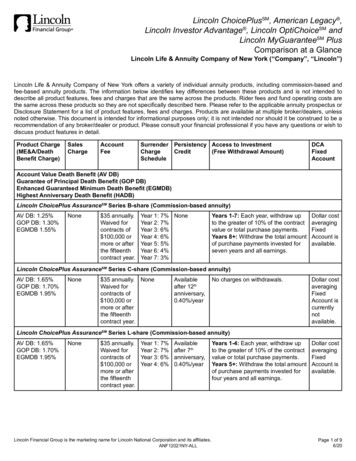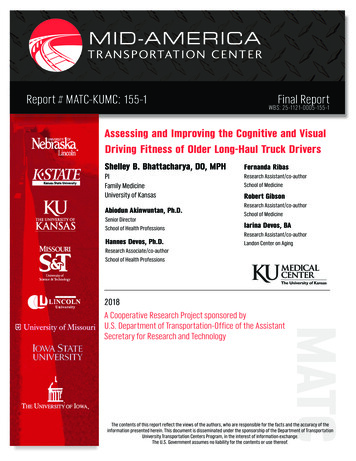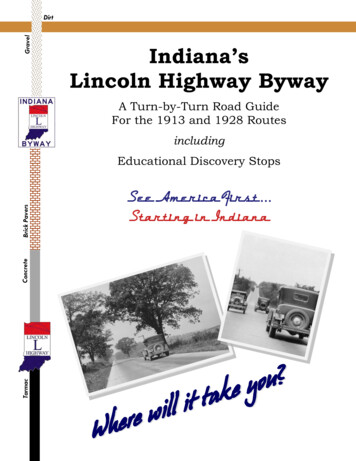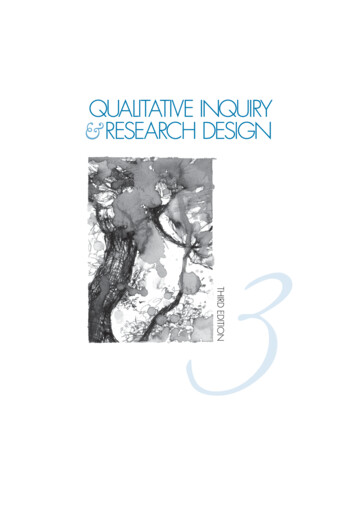
Transcription
I dedicate this book to Uncle Jim(James W. Marshall, M.D., 1915–1977)who provided love, support, and inspiration.
University of Nebraska, Lincoln
FOR INFORMATION:SAGE Publications, Inc.2455 Teller RoadThousand Oaks, California 91320E-mail: order@sagepub.comCopyright 2013 by SAGE Publications, Inc.All rights reserved. No part of this book may be reproducedor utilized in any form or by any means, electronic ormechanical, including photocopying, recording, or byany information storage and retrieval system, withoutpermission in writing from the publisher.SAGE Publications Ltd.1 Oliver’s Yard55 City RoadLondon EC1Y 1SPPrinted in the United States of AmericaLibrary of Congress Cataloging-in-Publication DataUnited KingdomCreswell, John W.SAGE Publications India Pvt. Ltd.B 1/I 1 Mohan Cooperative Industrial AreaQualitative inquiry and research design : choosing amongfive approaches /Mathura Road, New Delhi 110 044John W. Creswell. — 3rd ed.IndiaSAGE Publications Asia-Pacific Pte. Ltd.p. cm.Previous ed. cataloged as: Qualitative inquiry & researchdesign. c2007.3 Church StreetIncludes bibliographical references and index.#10-04 Samsung HubISBN 978-1-4129-9531-3 (cloth)ISBN 978-1-4129-9530-6 (pbk.)Singapore 0494831. Social sciences—Methodology. I. Creswell, John W.Qualitative inquiry & research design. II. Title.H61.C73 2013300.72—dc23 2011050629Publisher: Vicki KnightAssociate Editor: Lauren HabibEditorial Assistant: Kalie KoscielakProduction Editor: Brittany BauhausCopy Editor: Melinda MassonTypesetter: C&M Digitals (P) Ltd.Proofreader: Sue IrwinIndexer: Diggs Publication Services, Inc.Cover Designer: Rose StoreyThis book is printed on acid-free paper.Marketing Manager: Nicole ElliottPermissions Editor: Adele Hutchinson12 13 14 15 16 10 9 8 7 6 5 4 3 2 1
Brief ContentsAbout the AuthorxivAcknowledgmentsxvAnalytic Table of Contents by ApproachxviList of Tables and Figuresxx1.Introduction12.Philosophical Assumptions andInterpretive Frameworks153.Designing a Qualitative Study424.Five Qualitative Approaches to Inquiry695.Five Different Qualitative Studies1116.Introducing and Focusing the Study1297.Data Collection1458.Data Analysis and Representation1799.Writing a Qualitative Study21310. Standards of Validation and Evaluation24311. “Turning the Story” and Conclusion269Appendix A. An Annotated Glossary of Terms282Appendix B. A Narrative Research Study—“Living in the Space Between Participant andResearcher as a Narrative Inquirer: Examining EthnicIdentity of Chinese Canadian Students asConflicting Stories to Live By”Elaine Chan303
Appendix C. A Phenomenological Study—“CognitiveRepresentations of AIDS”Elizabeth H. Anderson and Margaret Hull Spencer327Appendix D. A Grounded Theory Study—“DevelopingLong-Term Physical Activity Participation:A Grounded Theory Study withAfrican American Women”Amy E. Harley, Janet Buckworth, Mira L. Katz,Sharla K. Willis, Angela Odoms-Young, andCatherine A. Heaney347Appendix E. An Ethnography—“RethinkingSubcultural Resistance: Core Values ofthe Straight Edge Movement”Ross Haenfler370Appendix F. A Case Study—“CampusResponse to a Student Gunman”Kelly J. Asmussen and John W. Creswell399References417Author Index435Subject Index442
Detailed ContentsAbout the AuthorxivAcknowledgmentsxvAnalytic Table of Contents by ApproachxviList of Tables and Figuresxx1. IntroductionPurpose and Rationale for the BookWhat Is New in This EditionPositioning MyselfSelection of the Five ApproachesNarrative ResearchPhenomenologyGrounded TheoryEthnographyCase StudyAudienceOrganization12267111212121212132. Philosophical Assumptions andInterpretive FrameworksQuestions for DiscussionPhilosophical AssumptionsA Framework for Understanding AssumptionsWhy Philosophy Is ImportantFour Philosophical AssumptionsWriting Philosophical AssumptionsInto Qualitative StudiesInterpretive FrameworksPostpositivismSocial ConstructivismTransformative FrameworksPostmodern PerspectivesPragmatism15161616181922222324252728
Feminist TheoriesCritical Theory and Critical Race Theory (CRT)Queer TheoryDisability TheoriesThe Practice of Using Social Justice InterpretiveFrameworks in Qualitative ResearchLinking Philosophy and Interpretive FrameworksSummaryAdditional ReadingsExercises2930323334353838403. Designing a Qualitative StudyQuestions for DiscussionThe Characteristics of Qualitative ResearchWhen to Use Qualitative ResearchWhat a Qualitative Study Requires From UsThe Process of Designing a Qualitative StudyPreliminary ConsiderationsSteps in the ProcessElements in All Phases of the ResearchEthical Issues During All Phases ofthe Research ProcessThe General Structure of a Plan or ProposalSummaryAdditional ReadingsExercises4243434749495051554. Five Qualitative Approaches to InquiryQuestions for DiscussionNarrative ResearchDefinition and BackgroundDefining Features of Narrative StudiesTypes of NarrativesProcedures for Conducting Narrative ResearchChallengesPhenomenological ResearchDefinition and BackgroundDefining Features of PhenomenologyTypes of PhenomenologyProcedures for ConductingPhenomenological 678082
Grounded Theory ResearchDefinition and BackgroundDefining Features of Grounded TheoryTypes of Grounded Theory StudiesProcedures for Conducting GroundedTheory ResearchChallengesEthnographic ResearchDefinition and BackgroundDefining Features of EthnographiesTypes of EthnographiesProcedures for Conducting an EthnographyChallengesCase Study ResearchDefinition and BackgroundDefining Features of Case StudiesTypes of Case StudiesProcedures for Conducting a Case StudyChallengesThe Five Approaches ComparedSummaryAdditional ReadingsExercises5. Five Different Qualitative StudiesQuestions for DiscussionA Narrative Study (Chan, 2010; see Appendix B)A Phenomenological Study (Anderson & Spencer, 2002;see Appendix C)A Grounded Theory Study (Harley et al., 2009;see Appendix D)An Ethnographic Study (Haenfler, 2004;see Appendix E)A Case Study (Asmussen & Creswell, 1995;see Appendix F)Differences Among the ApproachesCentral Features of Each ApproachSelecting Your ApproachSummaryAdditional 125128
6. Introducing and Focusing the StudyQuestions for DiscussionThe Research Problem StatementThe Purpose StatementThe Research QuestionsThe Central QuestionSubquestionsSummaryAdditional ReadingsExercises1291301301341381381401421431437. Data CollectionQuestions for DiscussionThe Data Collection CircleThe Site or IndividualAccess and RapportInstitutional Review BoardsAccess and Rapport Within the Five ApproachesPurposeful Sampling StrategyParticipants in the SampleTypes of SamplingSample SizeForms of DataInterviewingObservationRecording ProceduresField IssuesAccess to the OrganizationObservationsInterviewsDocuments and Audiovisual MaterialsEthical IssuesStoring DataFive Approaches ComparedSummaryAdditional 1571631661681711711721721741741751761771771788. Data Analysis and RepresentationQuestions for DiscussionThree Analysis StrategiesThe Data Analysis SpiralOrganizing the Data179179180182182
Reading and MemoingDescribing, Classifying, and Interpreting Data IntoCodes and ThemesInterpreting the DataRepresenting and Visualizing the DataAnalysis Within Approaches to InquiryNarrative Research Analysis and RepresentationPhenomenological Analysis and RepresentationGrounded Theory Analysis and RepresentationEthnographic Analysis and RepresentationCase Study Analysis and RepresentationComparing the Five ApproachesComputer Use in Qualitative Data AnalysisAdvantages and DisadvantagesA Sampling of Computer ProgramsUse of Computer Software ProgramsWith the Five ApproachesHow to Choose Among the Computer ProgramsSummaryAdditional ReadingsExercises9. Writing a Qualitative StudyQuestions for DiscussionSeveral Writing StrategiesReflexivity and Representations in WritingAudience for Our WritingsEncoding Our WritingsQuotes in Our WritingsOverall and Embedded Writing StrategiesNarrative Writing StructureOverall StructureEmbedded StructurePhenomenological Writing StructureOverall StructureEmbedded StructureGrounded Theory Writing StructureOverall StructureEmbedded StructureEthnographic Writing StructureOverall StructureEmbedded 25226228229229231232233234
Case Study Writing StructureOverall StructureEmbedded StructureA Comparison of Narrative StructuresSummaryAdditional ReadingsExercises23623623823924024024110. Standards of Validation and EvaluationQuestions for DiscussionValidation and Reliability in Qualitative ResearchPerspectives on ValidationValidation StrategiesReliability PerspectivesEvaluation CriteriaQualitative PerspectivesNarrative ResearchPhenomenological ResearchGrounded Theory ResearchEthnographic ResearchCase Study ResearchComparing the Evaluation Standards ofthe Five ApproachesSummaryAdditional 26226411. “Turning the Story” and ConclusionTurning the StoryA Case StudyA Narrative StudyA PhenomenologyA Grounded Theory StudyAn 4277280265265266268
Appendix A. An Annotated Glossary of TermsAppendix B. A Narrative Research Study—“Living in the Space Between Participant andResearcher as a Narrative Inquirer:Examining Ethnic Identity ofChinese Canadian Students asConflicting Stories to Live By”Elaine Chan282303Appendix C. A Phenomenological Study—“Cognitive Representations of AIDS”Elizabeth H. Anderson and Margaret Hull Spencer327Appendix D. A Grounded Theory Study—“Developing Long-Term Physical Activity Participation:A Grounded Theory Study WithAfrican American Women”Amy E. Harley, Janet Buckworth, Mira L. Katz,Sharla K. Willis, Angela Odoms-Young, andCatherine A. Heaney347Appendix E. An Ethnography—“RethinkingSubcultural Resistance: Core Values ofthe Straight Edge Movement”Ross Haenfler370Appendix F. A Case Study—“Campus Response to a Student Gunman”Kelly J. Asmussen and John W. Creswell399References417Author Index435Subject Index442
About the AuthorJohn W. Creswell, PhD, has been a professor ofeducational psychology at the University ofNebraska-Lincoln since 1978. In addition to teaching at the university, he has authored numerousarticles on mixed methods research, qualitativemethodology, and general research design and12 books, many of which focus on types ofresearch designs, comparisons of different qualitative methodologies, and the nature and use ofmixed methods research. His books are translated into many languages and used around the world. For the last fiveyears, Dr. Creswell served as a codirector at the Office of Qualitative andMixed Methods Research at the University of Nebraska, which providedsupport for scholars incorporating qualitative and mixed methods researchinto projects for extramural funding. He served as the founding coeditorof the Sage Journal of Mixed Methods Research, and as an adjunct professor of family medicine at the University of Michigan where he assistedinvestigators in the health sciences and education with research methodology for National Institutes of Health (NIH) and National ScienceFoundation projects. He also served extensively as a consultant in thehealth services research area for the U.S. Department of Veterans Affairs.Dr. Creswell was a Senior Fulbright Scholar to South Africa and in 2008lectured to faculty at five universities on education and the health sciences. In 2012 he served as a Senior Fulbright Scholar to Thailand.Recently he served as a co-leader of a national working group developingguidelines for mixed methods research for NIH. He lives with his wife,Karen, in Lincoln, Nebraska.xiv
AcknowledgmentsIam most thankful to the many students in my qualitative researchmethods classes at the University of Nebraska–Lincoln who helped toshape this book over the years. They offered suggestions, providedexamples, and discussed the material in this book. Also, I benefited fromcapable scholars who helped to shape and form this book in the first edition: Paul Turner, Ken Robson, Dana Miller, Diane Gillespie, GregorySchraw, Sharon Hudson, Karen Eifler, Neilida Aguilar, and Harry Wolcott.Ben Crabtree and Rich Hofmann helped form the first edition text significantly and encouraged me to proceed, and they diligently and timelyresponded to Sage’s request to be first edition external reviewers. In addition, Keith Pezzoli, Kathy O’Byrne, Joanne Cooper, and Phyllis Langtonserved as first edition reviewers for Sage and added insight into contentand structure that I could not see because of my closeness to the material.To the reviewers for this third edition, I appreciate your time and effortreviewing the draft of my book. As always, I am indebted to C. DeborahLaughton, who served as my acquisition editor for the first edition, to LisaCuevas Shaw who served as editor for the second edition, and to VickiKnight who helped as acquisition editor for this third edition. Also for allof the editions, members of the Office of Qualitative and Mixed MethodsResearch (OQMMR) all provided valuable input. I especially single out Dr.Vicki Plano Clark, Dr. Ron Shope, and Yuchun Zhang who have beeninstrumental in refining and shaping my ideas about qualitative researchthrough these several editions. Also, I am grateful to the Department ofEducational Psychology. Finally, to members of my family—Karen, David,Kasey, Johanna, and Bonny—thanks for providing me with time to spendlong hours writing and revising this book. Thank you all.xv
Analytic Table ofContents by ApproachNARRATIVE RESEARCHUse of narrative approachesKey books and referencesDefinition and backgroundDefining features of narrative researchTypes of narrative studiesProcedures in conducting narrative researchChallenges in using narrative researchFocus of narrative researchExample of a narrative study, Appendix BResearch problemPurpose statementResearch questionsIndividual or site to be studiedAccess and rapport issuesSampling strategyForms of dataEthical issuesData analysisWriting a narrative studyStandards of evaluationCase study “turned” into a narrative 89220258272PHENOMENOLOGYUse of psychological approachKey books and references1112xvi
Analytic Table of Contents by ApproachDefinition and backgroundDefining features of phenomenologyTypes of phenomenologyProcedures in conducting phenomenologyChallenges in using phenomenologyFocus of phenomenologyExample of a phenomenological study, Appendix CResearch problemPurpose statementResearch questionsParticipants in a phenomenological studyAccess issuesSampling strategyForms of dataEthical issuesData analysisWriting a phenomenological studyStandards of evaluationCase study “turned” into a phenomenology 259273GROUNDED THEORYUse of sociological approachKey books and referencesDefinition and backgroundDefining features of grounded theoryTypes of grounded theory studiesProcedures in conducting grounded theory researchChallenges in using grounded theory researchFocus of grounded theory researchExample of a grounded theory study, Appendix DResearch problemPurpose statementResearch questionsParticipants in a grounded theory studyAccess issuesSampling strategyForms of dataEthical issues11128385868889122347134136139150154157162174
xviii Qualitative Inquiry and Research DesignData analysisWriting a grounded theory studyStandards of evaluationCase study “turned” into a grounded theory study195229260273ETHNOGRAPHYUse of anthropological, sociological, andinterpretive approachesKey books and referencesDefinition and backgroundDefining features of ethnographyTypes of ethnographiesProcedures in conducting ethnographyChallenges in using ethnographyFocus of ethnographyExample of an ethnography, Appendix EResearch problemPurpose statementResearch questionsSite to be studiedAccess and rapport issuesSampling strategyForms of dataEthical issuesData analysisWriting an ethnographyStandards of evaluationCase study “turned” into 62174197232262274CASE STUDYUse of evaluation approachKey books and referencesDefinition and backgroundDefining features of case studiesTypes of case studiesProcedures for conducting a case studyChallenges in using a case study1112979899100101
Analytic Table of Contents by ApproachFocus of a case studyExample of a case study, Appendix FResearch problemPurpose statementResearch questionsSite to be studiedAccess and rapport issuesSampling strategyForms of dataEthical issuesData analysisWriting a case studyStandards of evaluationA case study revisited before “turning” xix122399134136140150154157162174199236264271
List ofTables and FiguresTABLESTable 1.1 Qualitative Approaches Mentionedby Authors and Their Disciplines/Fields8Table 2.1 The Research Process17Table 2.2 Philosophical Assumptions WithImplications for Practice21Table 2.3 Interpretive Frameworks andAssociated Philosophical Beliefs36Table 3.1 Characteristics of Qualitative Research46Table 3.2 Ethical Issues in Qualitative Research58Table 4.1 Contrasting Characteristics ofFive Qualitative Approaches104Table 6.1 Words to Use in Encoding the Purpose Statement136Table 7.1 Data Collection Activities by Five Approaches148Table 7.2 Typology of Sampling Strategies in Qualitative Inquiry158Table 8.1 General Data Analysis Strategies Advanced bySelect Authors181Table 8.2 Data Analysis and Representation byResearch Approaches190Table 9.1 Overall and Embedded Writing Structures andthe Five Approaches221Table 10.1 Perspectives and Terms Used in Qualitative Validation244xx
List of Tables and Figures xxiFIGURESFigure 5.1 Differentiating Approaches by Foci122Figure 6.1 Sample Research Problem Section(Introduction) to a Study132Figure 7.1 Data Collection Activities146Figure 7.2 Sample Human Subjects Consent-to-Participate Form152Figure 7.3 A Compendium of Data Collection Approaches inQualitative Research160Figure 7.4 Sample Interview Protocol or Guide165Figure 7.5 Sample Observational Protocol169Figure 8.1 The Data Analysis Spiral183Figure 8.2 Layers of Analysis in the Gunman Case188Figure 8.3 Template for Coding a Narrative Study207Figure 8.4 Template for Coding a Phenomenological Study207Figure 8.5 Template for Coding a Grounded Theory Study208Figure 8.6 Template for Coding an Ethnography208Figure 8.7 Template for Coding a Case Study(Using a Multiple or Collective Case Approach)209Figure 8.8 Features to Consider When ComparingQualitative Data Analysis Software210Figure 11.1 Visual Diagram of the Three Componentsof Qualitative Research270
1IntroductionIfirst began work on this book during a 1994 summer qualitative seminar in Vail, Colorado, sponsored by the University of Denver underthe able guidance of Edith King of the College of Education. At thatseminar I facilitated a discussion about qualitative data analysis. I began ona personal note, introducing one of my recent qualitative studies—a casestudy of a campus response to a student gun incident (Asmussen &Creswell, 1995) (see Appendix F in this book). I knew this case mightprovoke some discussion and present some complex analysis issues. Itinvolved a Midwestern university’s reaction to a gunman who entered anactuarial science undergraduate class with a semiautomatic rifle andattempted to fire on students in his class. The rifle jammed and did notdischarge, and the gunman fled and was captured a few miles away.Standing before the group, I chronicled the events of the case, thethemes, and the lessons we learned about a university reaction to a neartragic event. Then, unplanned, Harry Wolcott of the University of Oregon,another resource person for our seminar, raised his hand and asked forthe podium. He explained how he would approach the study as a culturalanthropologist. To my surprise, he had “turned” my case study into ethnography, framing the study in an entirely new way. After Harry had concluded, Les Goodchild, then of Denver University, discussed how hewould examine the gunman case from a historical perspective. We all had,then, two different renderings of the incident, surprising “turns” of mycase study using different qualitative approaches. It was this event thatsparked an idea that I had long harbored—that the design of a qualitativestudy related to the specific approach taken to qualitative research. Ibegan to write the first edition of this book, guided by a single, compellingquestion: How does the type or approach of qualitative inquiry shape thedesign or procedures of a study?1
2 Qualitative Inquiry and Research DesignPURPOSE AND RATIONALE FOR THE BOOKI am now into the third edition of this book, and I am still formulating ananswer to this question. My primary intent in this book is to examine fivedifferent approaches to qualitative inquiry—narrative, phenomenology,grounded theory, ethnography, and case studies—and put them side-byside so that we can see their differences. These differences can be mostvividly displayed by exploring their use throughout the process of research,including the introduction to a study through its purpose and researchquestions; data collection; data analysis; report writing; and standards ofvalidation and evaluation. For example, by studying qualitative articles injournals we can see that research questions framed from grounded theorylook different than questions framed from a phenomenological study.This combination of the different approaches and how their distinctiveness plays out in the process of research is what distinguishes this bookfrom others on qualitative research that you may have read. Most qualitativeresearchers focus on only one approach—say ethnography or groundedtheory—and try to convince their readers of the value of that approach. Thismakes sense in our highly specialized world of academia. However, studentsand beginning qualitative researchers need choices that fit their researchproblems and that suit their own interests in conducting research. Hopefully,this book opens up the expanse of qualitative research and invites readersto examine multiple ways of engaging in the process of research. It providesqualitative researchers with options for conducting qualitative inquiry andhelps them with decisions about what approach is best to use in studyingtheir research problems. With so many books on qualitative research ingeneral and on the various approaches of inquiry, qualitative research students are often at a loss for understanding what options (i.e., approaches)exist and how one makes an informed choice of an option for research.By reading this book, I hope that you will gain a better understanding of thesteps in the process of research, learn five qualitative approaches to inquiry, andunderstand the differences and similarities among the five approaches toinquiry (see the glossary in Appendix A for definitions of terms in bold italics).WHAT IS NEW IN THIS EDITIONSince I wrote the first and second editions of this book, the content of thebook has both remained the same and changed. In this edition I introduceseveral new ideas:
Chapter 1. Introduction 3 Based on reviewers’ feedback, I reworked Chapter 2 on the philosophical assumptions and the interpretive frameworks used byqualitative researchers. I needed to better position philosophy andframeworks within the overall process of research. I also sought toclarify the relationship between philosophy and interpretive frameworks, and to discuss interpretive frameworks as they are currentlybeing used in qualitative research (Denzin & Lincoln, 2011). In Chapter 3 I have added a new section on ethical issues thattraces the types of qualitative ethical dilemmas likely to arise at different phases of the research process. In this way I am expandingthe ethical coverage in this book. In discussing each of the five approaches in this book, as mentionedin Chapter 4, I have added passages on each of the five related to“defining characteristics” of the approach. Readers will have my bestassessment of the key features of the approach summarized in oneplace. Also in Chapter 4 I have moved from relying primarily on onebook for each approach in the last edition to using two books toconstruct a picture of the approach in this edition. I have done thisbecause of the popularity of multiple approaches for understandingeach approach, and the value of constructing an understanding ofeach approach from multiple authors. I also updated the illustrative articles that I used in the book inChapter 5 and removed articles that were outdated. Consequently,I added two new articles: one in narrative research (Chan, 2010)and one in grounded theory (Harley et al., 2009). I decided to keepthe gunman incident case study in (Asmussen & Creswell, 1995)because the issue of safety on college campuses remains a criticalconcern in the literature given recent campus violence. In the discussion about research questions, I simplified the discussion about subquestions and focused on how subquestions subdivide the central question into several parts. I also provided additionalillustrations of subquestions drawn from different qualitativeapproaches. In the area of data collection, I cannot overlook the technologicaldevelopments in data collection, and any treatment of qualitativemethods needs to incorporate new ways of gathering qualitativedata electronically. I have added online methods of qualitative datacollection into the discussion in Chapter 7. I have also added information about observational techniques to expand discussions inearlier editions of this book.
4 Qualitative Inquiry and Research Design In data analysis, in Chapter 8, I added in new techniques that arebeing discussed for analyzing the data in each of the five approaches,and I cite recent references. I also updated the discussion aboutqualitative computer software analysis packages. In the writing of qualitative research, as presented in Chapter 9, Iadded more information about reflexivity, its importance, and howit might be incorporated into a qualitative study. At the end of each chapter you will find sample exercises to practice specific skills introduced in the chapter. Many of these exercises have been rewritten in this new edition to reflect my growingunderstanding of the specific skills that a qualitative researcherneeds to know. In the final chapter, I have not only “turned” the initial qualitativegunman case study into a narrative project, a phenomenology, agrounded theory study, and an ethnography, but I have made moreexplicit what changes actually occurred in this reworking. As with all new editions, I have updated the references to includerecent books on qualitative research methods as well as select journal articles that illustrate these methods.Many areas have also remained the same as in the last edition. Theseinclude: The core characteristics of qualitative research have remained thesame. An emphasis on social justice as one of the primary features ofqualitative research is continued in this edition. While a social justice orientation may not be for everyone, it has again been givenprimacy in the latest edition of the SAGE Handbook of QualitativeResearch (Denzin & Lincoln, 2011). A healthy respect exists for variations within each of the fiveapproaches. I have come to understand that there is no single wayto approach an ethnography, a grounded theory study, and soforth. I have selectively chosen what I believe to be the most popular approaches within each approach and to highlight books thatemphasize them. On a similar note, I have continued to use the five approaches thathave now stood the test of time since the first edition. This is notto say that I have not considered additional approaches. Participatoryaction research, for example, could certainly be a sixth approach,
Chapter 1. Introduction 5but I include some discussion of it in the interpretive framework passages in Chapter 2 (Kemmis & Wilkinson, 1998). Also,discourse analysis and conversational analysis could certainlyhave been included as an additional approach (Cheek, 2004),but I added some thoughts about conversational approaches innarrative approaches. Mixed methods, too, is sometimes soclosely associated with qualitative research that it is consideredone of the genres (see Saldaña, 2011). However, I see mixedmethods as a distinct methodology from qualitative inquiry,and one that bridges qualitative and quantitative research.Further, it has its own distinct literature (see Creswell & PlanoClark, 2011), and thus I wanted to limit the scope of this bookto qualitative approaches. Accordingly, I have chosen to keepthe five approaches that I started with and to expand withinthese five approaches. I continue to provide resources throughout the book for thequalitative researcher. I include a detailed glossary of terms (andhave added terms from the last edition), an analytic table of contents that organizes the material in this book according to the fiveapproaches, and complete journal articles that model designingand writing a study within each of the five approaches. For bothinexperienced and experienced researchers, I supply recommendations at the ends of chapters for further reading that can extendthe material in this book. The term that I used in the first edition, traditions, has now beenreplaced by approaches, and I continue this use of terms in thethird edition. My approach signals that I not only want to respectpast approaches, but I also want to encourage current practices inqualitative research. Other writers have referred to the approachesas “strategies of inquiry” (Denzin & Lincoln, 2005), “varieties”(Tesch, 1990), or “methods” (Morse & Ri
3. Designing a Qualitative Study 42 4. Five Qualitative Approaches to Inquiry 69 5. Five Different Qualitative Studies 111 6. Introducing and Focusing the Study 129 7. Data Collection 145 8. Data Analysis and Representation 179 9. Writing a Qualitative Study 213 10. Standards of Vali
